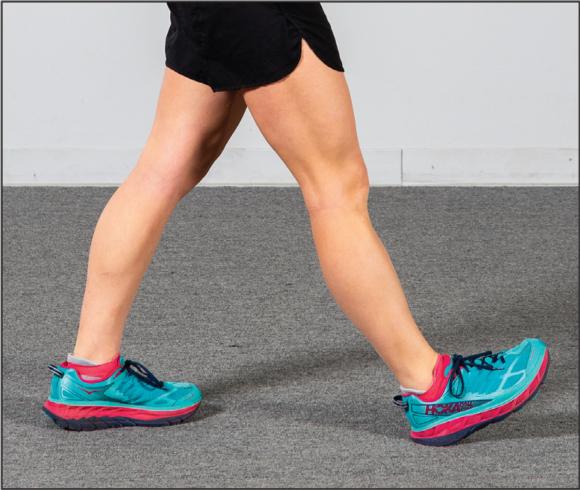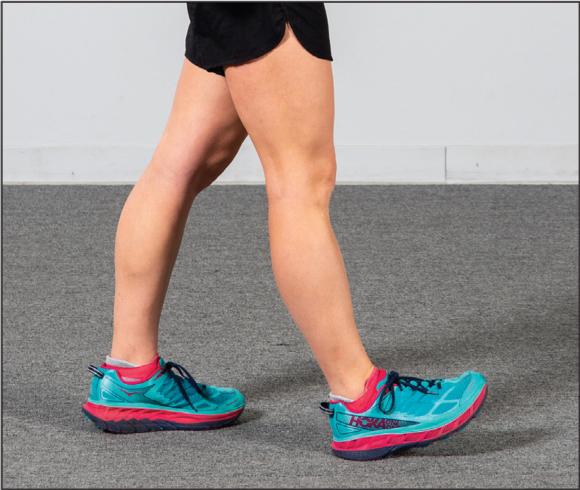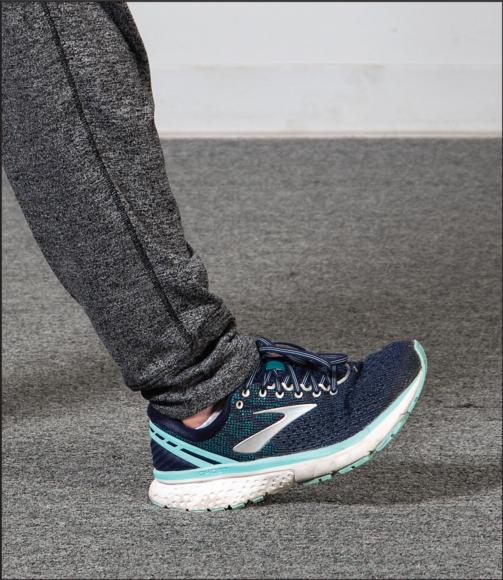Short, quick steps are the key to moving faster
This is an excerpt from Walking Solution, The by Lee Scott,Michele Stanten.
Progression 2: Short, Quick Steps
Our second progression addresses the position and movement of the lower body.
If you had to guess which one of us - Michele at 5'8" or Lee at 5'6" - is speedier, you'd probably pick Michele. Most people think taller people with longer legs can walk faster (Michele hears this all the time), which is reasonable. But the truth is, the shorter person can be faster than the taller one, and this isn't an anomaly. The gold medalist in the women's 20K (12.4 miles) racewalk at the 2016 Olympics stands at only 5'3" tall and averaged a seven-minute-per-mile pace while walking, beating out many taller competitors.
The key to moving faster isn't bigger steps; it's a quicker step cadence. Progression 2 focuses on getting the feet and legs to move more quickly while minimizing impact.
Take Short Steps
The significant change in this progression is a shortening of the stride in front of the body. This is done by placing the heel of the landing foot just in front of the body, ahead of the COM. This position minimizes the effort required to push the weight of the body over the front foot. The farther out in front of the body the foot is placed, the more effort it takes to bring the opposite foot forward. Walking has been described as a series of forward falls [3]. But when the leg is extended far out in front of the body (figure 4.8) it acts like a brake, decreasing speed and creating a bouncy, choppy stride that increases impact to the joints in the lower body, especially the knee. When the foot instead lands closer to the body (figure 4.9), there is less impact, and it is easier to roll body mass over the front foot and swing the back foot forward to catch the body as it falls forward onto the next step.

Figure 4.8 With the leg farther out in front of the body, it is more work to support and move the COM over the front leg.

Figure 4.9 When the foot lands closer to the body, the COM is more supported, and it takes less effort to move it over the front leg.
This small change to foot placement is remarkably challenging for many people. They are accustomed to what an aerobic walk feels like, and it usually involves a longer stride. Encourage patience with the shorter stride, even though many describe it as feeling like baby steps.
Here are three ways to help your walkers see how short their forward steps should be:
Option 1
- Have walkers press their heels, glutes, shoulder blades, and backs of heads against a wall (remove any waist packs or water bottle holders).
- Identify this as the walking posture (it is easier to maintain while moving).
- Maintaining the line of the body from ankle to crown of the head, let the body fall forward away from the wall.
- As soon as both heels peel off from the ground, step one foot forward to stop the fall. Note: The goal is not to wait as long as possible to break the fall. Lift and place the front landing foot as soon as both heels start to peel off the ground.
- The place where the foot lands shows an ideal stride length.
Option 2
- Stand on a level surface, feet together, and hold on to a wall, tree, railing, or back of a bench with one hand for balance.
- Raise one knee up to hip height, the foot of that leg dangling below.
- Lower the heel of that dangling foot straight down to the ground, not back to the starting position.
- This is about the size of the step forward, about three to five inches, that should be taken.
Option 3
- Start by taking big steps and feel the bouncing in the body.
- Then take itty-bitty steps, like kids do at the pool when they are running and the lifeguard yells at them to walk.
- Then go back to the long, bouncy strides.
- Feel the difference?
- Now, shorten the stride until the bouncing is eliminated and stick with that.
If you notice any of your walkers bouncing while they walk, the stride has lengthened to the more familiar higher-impact gait, and they have probably slowed down. Remind them to shorten steps in front of the body. You'll give this cue frequently when leading walking groups.
Land on the Heel
A key feature of the walking gait is landing with the toes of the front foot up and the heel down (figure 4.10). While directing walkers' focus to heel placement, it's helpful to encourage awareness to range of motion around the ankle. Good range of motion at the ankle as the front heel strikes results in good positioning of the entire leg. The knee of that landing leg is in extension so that the leg looks straight to the observer. If the foot lands flat or on the forefoot, the knee is in flexion and the walk turns into a shuffle or possibly a jog. Heel-down and toe-up foot placement facilitates a smooth heel-to-toe roll that maximizes the range of motion at the ankle. For people with knee injuries or weakness, an emphasis on knee extension builds strength in the quadriceps muscles, helping to stabilize the joint and protect it from injury. Also, a straight-leg landing lowers the risk for knee injury because the braking load of landing is distributed throughout the entire leg rather than in the knee ligaments, as happens when a bent knee takes more impact while running or jogging.

Figure 4.10 As the front leg steps forward, land on the heel, pulling the toes up toward the shin.
A side effect of increasing step cadence is that walkers often feel shin fatigue, which they will describe as shin pain, even shin splints. It is uncommon for walkers to get shin splints, but the shin fatigue they experience from increasing the cadence can be debilitating and extremely uncomfortable. Encourage them by telling them that this muscular fatigue pain typically decreases over time as they become stronger and familiar with the new technique. See Ease Shin Pain section later in this chapter for ways to help your clients.
SHOP

Get the latest insights with regular newsletters, plus periodic product information and special insider offers.
JOIN NOW


